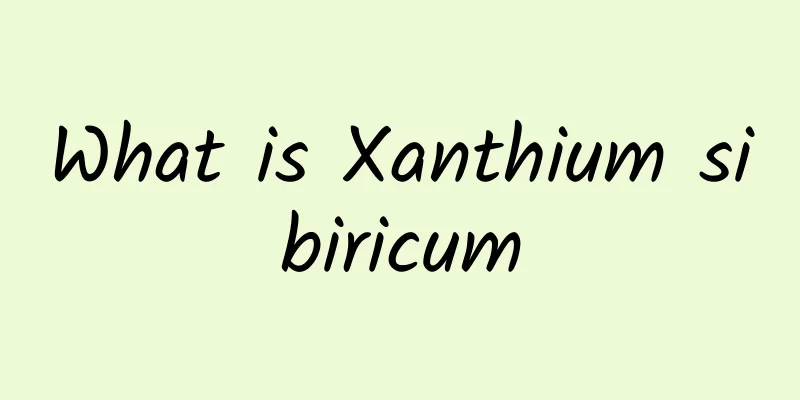What is Xanthium sibiricum

|
Xanthium sibiricum is a relatively common traditional Chinese medicine. It has certain toxicity and can play a certain role in the treatment of rhinitis. It is an annual herbaceous plant of the Asteraceae family and is widely cultivated in Northeast my country and North China. Xanthium sibiricum can be used for foot bathing to treat diseases. When using Xanthium sibiricum to treat diseases, be sure to follow the doctor's advice to avoid adverse effects on your health due to side effects. What is Xanthium sibiricum Xanthium sibiricum, the name of a traditional Chinese medicine. Alias: Horse head, Xanthium sibiricum, old Xanthium sibiricum, Taoist head, prickly naked, Canglangzi, Mian Canglangzi, Qiangzi naked, Qingjizi, Qiangzi, Chitoupo, Hu Cangzi, wild eggplant, pig ear, vegetable ear, Cangcangzi, also known as magnetic head mang (chitou mang) in Cantonese. The fruit with involucre of Xanthium sibiricum, an annual herb of the Asteraceae family, belongs to the genus Xanthium. Xanthium sibiricum is a commonly used Chinese herbal medicine with the effects of dispersing wind, removing dampness and opening the orifices. Distributed in Heilongjiang, Liaoning, Jilin, Inner Mongolia, Hebei, Anyang and other places. Italian Xanthium is an alien harmful species that affects agricultural and forestry production. Preparation method ① Xanthium sibiricum: Take the original medicinal material and remove impurities. Crush when using. ② Stir-fry Xanthium sibiricum: Take Xanthium sibiricum, place it in a preheated frying container, heat it over medium heat, and fry until the surface is dark yellow and the thorns are burnt, and the inside is light yellow. Take it out, let it cool, grind to remove the thorns, and sieve it. Crush when using. Physiological characteristics Xanthium sibiricum is an annual herb. Its fruit is spindle-shaped or oval, 1 to 37.5px long and 0.4 to 17.5px in diameter. The surface is yellow-brown or yellow-green, with hooked thorns all over the body, two thicker thorns on the top, separated or connected, and a fruit stalk mark at the base. It is hard and tough, with a longitudinal septum in the center of the cross section, and two chambers, each containing one achene. The achene is slightly fusiform, with one side relatively flat and a protruding stylopodium at the top. The pericarp is thin, gray-black, and has longitudinal stripes. It often grows in plains, hills, low mountains, wilderness roadsides and field edges. |
<<: The role and efficacy of kudzu root
>>: Can Dendrobium be used to make wine?
Recommend
What are the effects and functions of blood vine?
Blood vine is a relatively unique plant. Its vine...
What are the effects of Pueraria root powder?
Nowadays, there are endless beauty and health pro...
When you drink tea bags, drip coffee, or chew gum, you are probably also eating plastic.
Do you know how much plastic there is in our live...
Is human the most dangerous animal in the world? Check out the correct answer
Figure 1: The deadliest animals. Ranked by estima...
Snakes soaked in wine for ten years without dying
From ancient times to the present, there are two ...
Is such a "happy" holiday really good for children? - Focus on childhood obesity
Author: Huo Liang, Associate Professor, Shengjing...
Let's learn more! Take a look at those cultural relics that are full of "time travel feeling". What's so cool about them?
Behind every rare cultural relic They all embody ...
Have you ever seen a 3.6-pound "big orange" fur ball?
The tiger in the picture below is called Ty, let’...
Can Cistanche be eaten directly?
In recent years, with the popularity of tradition...
What are the effects of Perilla?
Many friends are not very familiar with Perilla, ...
The efficacy and function of goat horns
Many people are not very clear about goat horns, ...
Why is Qinling Mountains called the “Central Water Tower”?
The Qinling Mountains unite the north and south a...
Is it possible for humans to achieve "immortality"? What conditions are needed and what problems need to be solved?
When I see some friends answering questions like ...
What is the medicinal value of the hawksbill turtle?
The hawksbill turtle is a type of turtle and a pa...
What are the taboos of Polygonum multiflorum tea
Polygonum multiflorum tea is different from the t...









